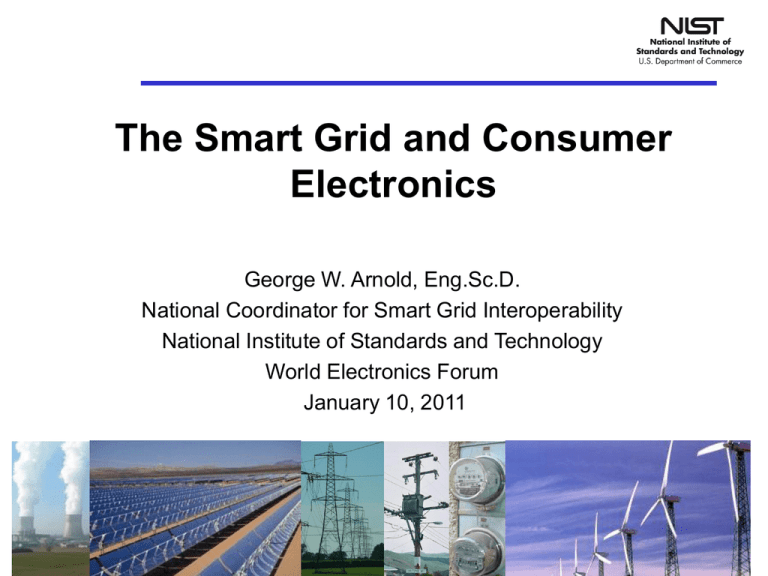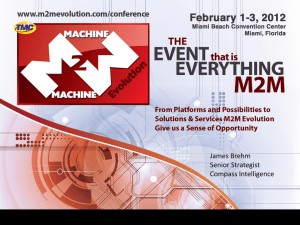Initiative Title - World Electronics Forum
advertisement

The Smart Grid and Consumer Electronics George W. Arnold, Eng.Sc.D. National Coordinator for Smart Grid Interoperability National Institute of Standards and Technology World Electronics Forum January 10, 2011 The Electric Grid “The supreme engineering achievement of the 20th century” - National Academy of Engineering 2 The Electric Grid 100 Years Ago It’s not too different today! Wall Street, 1913 Edison Pearl Street Station, 1882 3 Smart Grid – A U.S. National Priority “It is the policy of the United States to support the modernization of the Nation's electricity [system]… to achieve…a Smart Grid.” Congress, EISA 2007 “We’ll fund a better, smarter electricity grid and train workers to build it…” President Barack Obama “To meet the energy challenge and create a 21st century energy economy, we need a 21st century electric grid…” Secretary of Energy Steven Chu “A smart electricity grid will revolutionize the way we use energy, but we need standards …” Secretary of Commerce Gary Locke The Grid Needs to be Modernized The Smart Grid integrates information technology and advanced communications into the power system in order to: • • • • Reduce Costs Use More Renewables Improve Reliability Support Electric Vehicle Charging 5 Reducing Cost 2007 Generation by Source Sources: (1) DoE EIA (2) Brattle Group • Half of U.S. coal plants are > 40 years old • Upgrade or replacement will cost $560 B by 2030 • Smart grid helps utilities and consumers reduce both peak and average use – thus reducing investment otherwise required – US per capita annual electricity usage = 13000 kWh – Japan per capita annual usage = 7900 kWh 6 Using More Renewables • Electricity generation accounts for 40% of human-caused CO2 • Smart grid enables dynamic control needed for much greater use of wind and solar Source: PJM 7 Increasing Reliability Power outages Minutes/year/customer 140 120 100 80 60 • $80 Billion /year cost to U.S. economy • Smart grid sensors and automated controls will improve reliability 40 20 0 US Japan Sources: (1) IEEE Benchmarking 2009 Results Distribution Reliability Working Group (2) Japan Ministry of Economy Trade and Industry 2010 (3) Lawrence Berkeley National Laboratory 8 Electric Vehicle Charging 2020 SUMMER LOAD IMPACT – NO UTILITY INVOLVEMENT* 26,000 Worst Case 24,000 22,000 MW 20,000 18,000 16,000 14,000 12,000 10,000 4 5 6 7 8 9 10 11 12 13 14 15 16 17 18 19 20 21 22 23 24 Initial Load Forecast Ports Rail T rucks Forklifts PEVs 2020 SUMMER LOAD IMPACT – WITH UTILITY INVOLVEMENT* 26,000 24,000 22,000 20,000 MW • Opportunity to use idle capacity on the grid • Smart grid enables charging management to avoid overload during peak periods 1 2 3 Hours 18,000 16,000 14,000 12,000 10,000 1 2 3 Hours 9 4 5 6 7 8 9 10 11 12 13 14 15 16 17 18 19 20 21 22 23 24 Initial Load Forecast Ports Rail T rucks Forklifts PEVs Source: Southern California Edison The Smart Grid Essential Concept Two-way flow of electricity and information Dynamic management of both supply and demand 10 Where Does the Power Go? Other — Miscellaneous Uses 19% Comm’l 36% AC 17% Res. 37% Cooking 2%Dishwasher 2% Computers 4% Indust.’l 27% Lights 15% Washer/dryer 6% TV 7% Heating 9% Refrigeration 10% Hot Water 9% Source: DoE EIA, 2008 data 11 Consumer Electronics Can Drive Innovation on Customer Side of the Meter NIST Smart Grid Reference Model • Home area network • Energy services interface • Home energy management systems/apps • Controllers • Displays • Sub-metering devices • Embedded smart gridaware intelligence 12 Standards are Critical: Smart Grid Interoperability Panel • • • • Public-private partnership created in Nov. 2009 620 member organizations Open, public process with international participation Coordinates standards developed by Standards Development Organizations (SDOs) – Identifies Requirements – Prioritizes standards development programs – Works with over 20 SDOs including IEC, ISO, ITU, CEA, IEEE, … • Web-based participation SGIP Twiki: http://collaborate.nist.go v/twikisggrid/bin/view/SmartGr id/SGIP 13 Benefits of Global Standards • Avoid unnecessary adaptations for different markets • Promote supplier competition • Encourage innovation • Lower costs for suppliers • Lower costs for utilities • Lower costs to end customers 14 Further Information • Web portal: http://www.nist.gov/smartgrid • Contact: – George Arnold, National Coordinator – Email: george.arnold@nist.gov – Telephone: +1.301.975.2232 15




